唐刁光胤寫生花卉 冊 立石葵花下襯雜卉
推薦分享
資源連結
連結到原始資料 (您即將開啟新視窗離開本站)後設資料
- 資料識別:
- 故畫001113N000000003
- 資料類型:
- 類型:繪畫
- 型式:靜態圖像
- 著作者:
- 刁光胤
- 主題與關鍵字:
- 奇石 秋葵
- 出版者:
- 數位化執行單位:國立故宮博物院
- 格式:
- 本幅 32.8x36.4公分、對幅 27.6x31.2公分、全幅 44.6x88.2公分
- 關聯:
- 石渠寶笈續編(重華宮),第三冊,頁1500&*故宮書畫錄(卷六),第四冊,頁1&*故宮書畫圖錄,第二十二冊,頁34-39&*刁光胤,一作光引,唐末雍京(今西安)人。黃巢之亂,隨僖宗避難至四川,復於昭宗天復年間(九O一—九O三)抵成都。善繪湖石、花竹、貓兔、鳥雀與龍水。在蜀中三十餘年,蜀人從其學者甚多,黃筌、孔嵩等人,曾親受其指導。 冊凡十幅,畫均設色,鮮麗精工,款金書「刁光胤」尤為奇特。一、桃花雙蝶,二、枯樹五羊,三、葵花立石,四、喬松臥兔,五、竹菊孤石,六、山貓遊蜂,七、老幹紅英,八、秋塘蜻蜓,九、水仙倚石,十、芙蓉蘸蘸水。 &*Tiao Kuang-yin was from Yung-chin (present-day Sian). To escape from the dangers of the Huang Chao rebellion, he fled to Szechwan with the emperor Hsi-tsung (r. 873 – 888). At the turn of the tenth century, he accompanied the emperor Chao-tsung (r.888-904) to Ch'eng-tu, Szechwan. He was noted for his paintings of rocks, flowers and bamboo, cats and rabbits, dragons and water, and birds. He lived in Szechwan for over thirty years, where he taught many pupils such as Huang Ch'üan and K'ung Sun. These ten album leaves, all rendered in color, are exquisitely executed in careful detail. The artist's signature in gold is particularly fine. The first album leaf depicts a blossoming peach tree and two butterflies; the second, five sheep beneath withered old trees; the third, sunflowers and an upright rock; the fourth, a rabbit resting beneath a stately pine; the fifth, bamboo and chrysanthemums around a solitary rock; the sixth, a wild cat chasing a bee; the seventh, an old trunk of a tree and red blossoms; the eighth, a dragonfly above an autumn pond; the ninth, narcissus and a curious rock; and the tenth, a water-drenched hibiscus.&*立石旁的秋葵花叢,花開茂盛。全幅的用筆精工,石以青綠設色,搭配黃色的花朵,在在都表現出一片盎然的秋意。
- 管理權:
- 國立故宮博物院
授權聯絡窗口
- 國立故宮博物院圖像授權、出版授權、影音資料授權-申請流程說明
http://www.npm.gov.tw/zh-TW/Article.aspx?sNo=03003061






